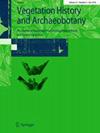叙利亚Abu Hureyra新石器时代植物利用的新视角:植物岩和球晶的综合研究
IF 1.9
2区 地球科学
Q1 PALEONTOLOGY
引用次数: 0
摘要
考古植物遗迹为人类经济从觅食向农耕的转变提供了重要证据,有助于了解早期村庄生活以及过去人们应对不断变化的环境条件的策略。然而,植物代用物的差异保存往往导致某些植物类型的代表性过高或过低。本研究分析了叙利亚北部Abu Hureyra新石器时代遗址(约11100-6000 bc)的植物岩和粪便球石,通过与先前广泛分析的烧焦植物宏观化石的结果进行比较,为人类经济和植物地学提供了新的视角。作为世界上最早和最大的前新石器时代B农业定居点之一,该遗址具有特别重要的意义,然而,在20世纪70年代建造Tabqa大坝后,它被淹没了。因此,这项研究为一些可以应用于档案材料的方法提供了一个案例研究,这些方法可以继续在具有高度考古意义的领域进行研究,这些领域已经无法进入。粪便球粒的存在表明,在该遗址的整个生命周期中,沉积物中都有粪便的背景成分,因此应该被认为是一些烧焦的植物大化石和植物岩的沉积途径。植物岩分析表明,在阿布胡雷拉的整个生命周期中,各种各样的植被类型被利用,这反映了该遗址位于几个过渡带边界的有利位置,这可能有助于其数千年的寿命。本文章由计算机程序翻译,如有差异,请以英文原文为准。
New perspectives on plant-use at neolithic Abu Hureyra, Syria: an integrated phytolith and spherulite study
Abstract Archaeobotanical remains contribute crucial evidence for shifts in human economy from foraging to farming, understanding early village life and the strategies employed by people in the past to cope with changing environmental conditions. However, differential preservation of plant proxies often leads to the over or under representation of some plant types. This research analyses phytoliths and faecal spherulites to provide new perspectives on human economy at the Neolithic site of Abu Hureyra, N. Syria (∼ 11100–6000 bc ) and plant taphonomy by comparing results with those from previous extensively analysed charred plant macro-fossils. This site is of especial importance as one of the earliest and largest pre-pottery Neolithic B farming settlements in the world, however, it was flooded following the construction of the Tabqa dam in the 1970s. This research therefore presents a case study for some of the methods that can be applied to archival material to continue research in areas of high archaeological significance that are no longer accessible. The presence of dung spherulites suggests a background faecal component in sediments throughout the lifespan of the site, and should therefore be considered as a depositional pathway for some of the charred plant macrofossils and phytoliths. Phytolith analyses show that a diverse range of vegetation types were exploited throughout the lifespan of Abu Hureyra, reflecting the site’s favourable position on the border of several ecotones, which likely contributed to its longevity over several millennia.
求助全文
通过发布文献求助,成功后即可免费获取论文全文。
去求助
来源期刊
CiteScore
5.30
自引率
8.00%
发文量
32
审稿时长
>12 weeks
期刊介绍:
Vegetation History and Archaeobotany publishes research papers, review articles and short contributions of high quality from Europe, the Americas and other parts of the world. It covers the entire field of vegetation history – mainly the development of flora and vegetation during the Holocene (but also from the Pleistocene), and including related subjects such as palaeoecology. Of special interest is the human impact upon the natural environment in prehistoric and medieval times; this is reflected in pollen diagrams as well as in plant macroremains from archaeological contexts.

 求助内容:
求助内容: 应助结果提醒方式:
应助结果提醒方式:


